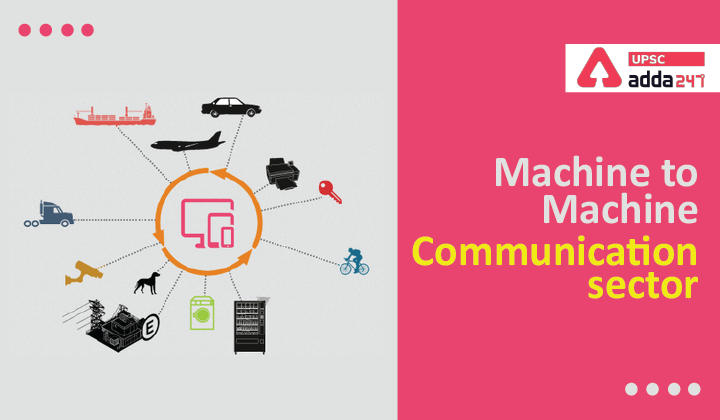Table of Contents
M2M Sector: Relevance
- GS 3: Science and Technology- developments and their applications and effects in everyday life.
Internet of Things in India: Context
- Government of India has identified M2M/ Internet of Things (IoT) is one of the fastest emerging technologies across the globe, providing enormous beneficial opportunities for society, industry, and consumers.
Machine to Machine sector: Government steps
Government has undertaken various steps to facilitate wider proliferation and innovation in Machine-to-Machine communication (M2M) sector.
- Guidelines for registration of M2MSP Service Providers and WPAN/WLAN Connectivity Providers have been issued to address concerns like connectivity with TSPs, KYC, traceability and encryption. Registration shall be carried out at field offices of DoT spread across the country.
- Though the existing Access Service Providers were already enabled to provide connectivity to the M2M/IoT networks, through the new licenses, an independent category of Service providers has been enabled to create, operate and provide Network for Interconnection of M2M/IoT devices.
- Released 13-digit numbering plan exclusively for M2M/IoT devices connected through Mobile networks.
- DoT has (Department of Telecommunication) has permitted use of embedded SIMs by allowing Telecom Service Providers to configure them Over The Air (OTA).
- This has enabled availability of sufficient numbering resources and led to a robust framework for mobile M2M eco-system in the country.
- In 2015, the government had unveiled the roadmap for machine-to-machine (M2M) communications which will act as a reference document for all such deployments and enable it to realise policy goals of ‘Make in India’ and ‘Digital India’.
What is M2M sector?
- M2M, is the acronym for Machine-to-Machine
- It is an emerging area in the field of telecom technologies.
- Machine to machine (M2M) refers to technologies that allow both wireless and wired systems to communicate with other devices of the same ability.
About M2M communication technology
- M2M uses a device (such as a sensor or meter) to capture an event, which is relayed through a network (wireless, wired or hybrid) to an application, that translates the captured event into meaningful information
- Apart from M2M, other terms are also being used to describe such communication – Internet of Things (IoT), Internet of Everything, Embedded Wireless, Smart systems (Homes, Cities, Meters, Grids etc.) with slightly different attributes to each term.
- IoT is connected network of embedded devices capable of having M2M communication without human intervention.
- M2M Communication when combined with logic of cloud services and remote operation becomes “Smart”.
M2M infrastructure
A typical M2M network consists of following building blocks:
- Wide area Network (WAN)
- Field area Network (FAN)
- Neighborhood area Network (NAN)
- Home area Network (HAN)/ Building Area Network (BAN) etc.
- Local area Network (LAN)
Application of M2M
- Transportation & Automotive: Possible M2M applications in the transportation and automotive
sectors include, Vehicle driver performance, fuel consumption, GPS tracking, E-Toll, Prevention of Vehicle Theft, Traffic control, Smart Parking, Emergency call (eCall) etc. - Utilities: M2M applications in this domain will be used to monitor and control the generation, transmission, Distribution and consumption by employing intelligent devices.
- Smart meters – water, energy & fuel consumption for home & industry, smart grid – monitor
load in real time, Electric Vehicle Charging Infrastructure are a few examples under this category.
- Smart meters – water, energy & fuel consumption for home & industry, smart grid – monitor
- Financial Transactions in Retail: In the case of remote located wireless/wired Point of Sale (PoS) terminals i.e., ATM machines (cash replacement, repair diagnostics, paper availability etc.), M2M modules are installed to provide communication for credit or debit card on-line financial transactions.
- Home/Buildings: Home /Building Automation deploy M2M modules & sensors in various utilities available in Home to measure and control energy, home health monitoring, HVAC, lighting, solar energy, wind energy and Building alarms – security, fire, intrusion, emergency
- Security and Surveillance: Applications in use are Alarm System Monitoring, Video Surveillance, real time monitoring, video analytics, in banking, retail, buildings in addition to smart cards and Facility management.
- Healthcare: Smart body sensors, Remote patient monitoring of residential/ institutional, communicate with smart phone and central server.M2M can be used in primary health centres in rural areas to enable speedy diagnosis and timely treatment.
- Consumer Electronics: Use cases include Remote monitor and control, interoperability between e-Readers, Gaming Devices, Picture Frames, TVsand Refrigerators etc.
Also Read:





 TSPSC Group 1 Question Paper 2024, Downl...
TSPSC Group 1 Question Paper 2024, Downl...
 TSPSC Group 1 Answer key 2024 Out, Downl...
TSPSC Group 1 Answer key 2024 Out, Downl...
 UPSC Prelims 2024 Question Paper, Downlo...
UPSC Prelims 2024 Question Paper, Downlo...




